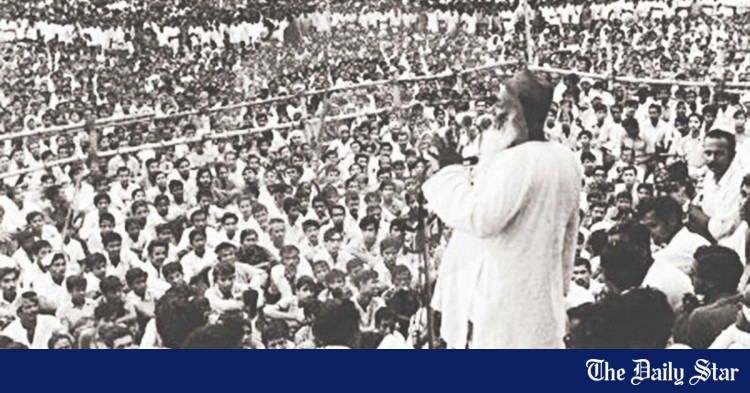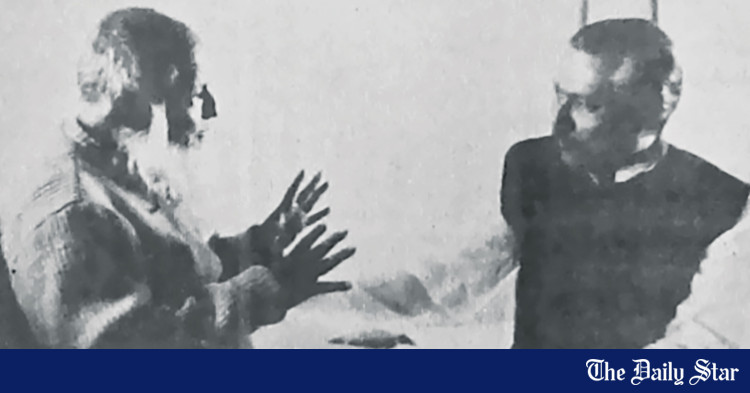Saif
Senior Member
- Joined
- Jan 24, 2024
- Messages
- 15,458
- Nation

- Axis Group

Date of Event:
Nov 18, 2024
Remembering a legacy of opposition, a vision of independence

VISUAL: ALIZA RAHMAN
Maulana Abdul Hamid Khan Bhashani (1880–1976) was one of Bengal's most charismatic and influential leaders, whose political contributions and multifaceted personality have been the subject of extensive evaluation. His leadership in the anti-colonial struggle, uncompromising efforts to unite the impoverished peasants of Bengal to alleviate their suffering, and his tireless political journey in pursuit of democracy were monumental. However, his enduring legacy lies in his steadfast commitment to oppositional politics and his vision of independence, which remain vital for sustaining democratic politics.
Maulana Bhashani's political journey began in the 1920s with his involvement in the Khilafat and non-cooperation movements in Bengal. However, Bhashani, at that time, did not become a prominent figure in Bengal politics like his contemporaries AK Fazlul Haq, Huseyn Shaheed Suhrawardy, Akram Khan, or Abul Hashim. Rather towards the late 1920s, he was compelled to move to Assam by landlords in Tangail, Pabna and Bogura because he organised peasants to protest against the landlords' exploitation. The Maulana rose to political prominence in Assam, where he popularised the Muslim League, and eventually served as its president. Bhashani became especially known for his opposition to the line corridor movement. Later, Muhammad Sa'dullah's Assam government arrested him. He was released in late 1947 on the condition that he would permanently leave Assam.
After relocating to Dhaka, Bhashani witnessed the Bengal Muslim League governing the province in an increasingly autocratic manner, continuing to perpetuate the suffering of the people even after Pakistan's independence. In response, he founded the East Pakistan Awami Muslim League in June 1949. Through his tireless efforts and extensive travels across East Bengal, the party rapidly gained traction, drawing many young people and disillusioned factions of the Muslim League. Bhashani played a crucial role in the United Front's victory in the 1954 elections, which delivered a decisive blow to the ruling Muslim League.
Bhashani also played a significant role in the party's evolution by advocating for the removal of "Muslim" from its name, renaming it the Awami League, and opposing separate electorates for minorities, a position supported by leaders like Suhrawardy in 1956. Ultimately, Bhashani left the Awami League due to disagreements over East Pakistan's autonomy, growing frustrated as the then Prime Minister Suhrawardy, whose stance was increasingly aligned with the US, ignored this crucial issue.
Notably, Bhashani was a trailblazer in anti-communal politics, staunchly opposing religious bigotry and hatred during the heightened sectarian tensions surrounding India's partition. He played a key role in establishing Ittefaq and revitalising Sangbad as a pro-people voice. These publications left an enduring legacy in shaping democratic opinion in both Pakistan and Bangladesh.
The Kagmari Conference of 1957, chaired by Bhashani, was one of the most influential cultural-literary-political gatherings in Pakistan. It challenged the restrictive socio-cultural environment and rejuvenating ties between East Bengal and West Bengal. Serving as a vibrant hub for both folk and modern literary circles, it fostered dynamic cultural exchange and drew significant public participation. During the conference, Bhashani and his leftist colleagues championed an anti-imperialist, non-aligned foreign policy, a stance that faced fierce opposition from Awami League leaders, making a split inevitable.
Bhashani aspired to steer the Awami League towards anti-imperialist, anti-feudal, and anti-communal principles. When this vision could not be realised, he founded the National Awami Party (NAP) in 1957 to pursue his mission independently.
Later, when Ayub Khan seized power, Bhashani appeared to adopt a cautious approach, refraining from strong opposition to strategically navigate the early years of military rule. He even offered concessions to Ayub, as reflected in his remark, "Don't disturb Ayub." This stance might have been influenced by broader global politics, particularly Ayub and Bhashani's mutual alignment with China and the dynamics of the 1965 Indo-Pak war, which shaped Bhashani's periodic inaction towards Ayub's regime.
Unfortunately, NAP later split along ideological lines, driven by debates over the Sino-Soviet conflict, despite not being a communist party.
However, this same Maulana later delivered the final blow to Ayub Khan's regime, igniting a grassroots movement that swept from cities to villages and ultimately contributed to the downfall of Pakistan's "great dictator."
In the final stage of his life, while reflecting on the most significant event of his life, in response to a question from a physician, Bhashani recounted the struggles of the people of the Indian subcontinent, particularly in Bengal, against British colonial rule. He said, this historic movement did not achieve complete liberation but, its partial success brought him immense joy. He spoke with pride about how the people of Bengal fought for their own freedom and contributed to the broader struggle for independence across the subcontinent.
However, by this time, NAP had been significantly weakened as many of his young communist associates defected to pursue more radical paths. These departures further destabilised the party, leaving it vulnerable on the eve of Pakistan's first national elections. Bhashani's bold and action-oriented politics, meanwhile, unsettled many in the middle class, prompting them to shift their support to the Awami League, which appeared to offer a more stable and pragmatic alternative.
Bhashani's decision not to contest the 1970 elections further compounded the challenges for his party, NAP. This decision weakened the party's position as the second-most significant political force after the Awami League, causing it to lose even more ground.
Despite this, Bhashani remained a pivotal figure during the 1971 Liberation War. His unwavering support for the war effort brought immense legitimacy to the cause and played a crucial role in garnering global attention towards Bangladesh's struggle for independence.
After the liberation of Bangladesh, Bhashani continued to exert significant influence by holding the ruling Awami League accountable on critical issues such as drafting the constitution and addressing the food crisis. His last major political initiative was the historic march protesting the Farakka Barrage issue, underscoring his enduring commitment to national causes.
Bhashani's political journey was marked by shifting trajectories and evolving strategies, often reflecting the complexities of his time. During the Pakistan period, he was perceived by some as sympathetic to India. However, following Bangladesh's independence, his actions were criticised as overly anti-Indian, with some attributing these stances to heightened communal tensions in the nascent country.
In the final stage of his life, while reflecting on the most significant event of his life, in response to a question from a physician, Bhashani recounted the struggles of the people of the Indian subcontinent, particularly in Bengal, against British colonial rule. He said, this historic movement did not achieve complete liberation but, its partial success brought him immense joy. He spoke with pride about how the people of Bengal fought for their own freedom and contributed to the broader struggle for independence across the subcontinent.
When he was asked why he always led the opposition but never took power, Maulana Bhashani explained that political power alone cannot guarantee the well-being of the people or eliminate all forms of discrimination. He emphasised that throughout his life, he championed political, economic, social, and cultural independence, urging people to strive for these goals. This did not mean he rejected power entirely; rather, he believed in waiting for the right conditions to achieve true independence in all its forms.
His response captured the essence of his identity as a leader of the oppressed and underscored his unwavering commitment to remaining in opposition throughout his political journey.
Priyam Paul is a journalist and researcher.
VISUAL: ALIZA RAHMAN
Maulana Abdul Hamid Khan Bhashani (1880–1976) was one of Bengal's most charismatic and influential leaders, whose political contributions and multifaceted personality have been the subject of extensive evaluation. His leadership in the anti-colonial struggle, uncompromising efforts to unite the impoverished peasants of Bengal to alleviate their suffering, and his tireless political journey in pursuit of democracy were monumental. However, his enduring legacy lies in his steadfast commitment to oppositional politics and his vision of independence, which remain vital for sustaining democratic politics.
Maulana Bhashani's political journey began in the 1920s with his involvement in the Khilafat and non-cooperation movements in Bengal. However, Bhashani, at that time, did not become a prominent figure in Bengal politics like his contemporaries AK Fazlul Haq, Huseyn Shaheed Suhrawardy, Akram Khan, or Abul Hashim. Rather towards the late 1920s, he was compelled to move to Assam by landlords in Tangail, Pabna and Bogura because he organised peasants to protest against the landlords' exploitation. The Maulana rose to political prominence in Assam, where he popularised the Muslim League, and eventually served as its president. Bhashani became especially known for his opposition to the line corridor movement. Later, Muhammad Sa'dullah's Assam government arrested him. He was released in late 1947 on the condition that he would permanently leave Assam.
After relocating to Dhaka, Bhashani witnessed the Bengal Muslim League governing the province in an increasingly autocratic manner, continuing to perpetuate the suffering of the people even after Pakistan's independence. In response, he founded the East Pakistan Awami Muslim League in June 1949. Through his tireless efforts and extensive travels across East Bengal, the party rapidly gained traction, drawing many young people and disillusioned factions of the Muslim League. Bhashani played a crucial role in the United Front's victory in the 1954 elections, which delivered a decisive blow to the ruling Muslim League.
Bhashani also played a significant role in the party's evolution by advocating for the removal of "Muslim" from its name, renaming it the Awami League, and opposing separate electorates for minorities, a position supported by leaders like Suhrawardy in 1956. Ultimately, Bhashani left the Awami League due to disagreements over East Pakistan's autonomy, growing frustrated as the then Prime Minister Suhrawardy, whose stance was increasingly aligned with the US, ignored this crucial issue.
Notably, Bhashani was a trailblazer in anti-communal politics, staunchly opposing religious bigotry and hatred during the heightened sectarian tensions surrounding India's partition. He played a key role in establishing Ittefaq and revitalising Sangbad as a pro-people voice. These publications left an enduring legacy in shaping democratic opinion in both Pakistan and Bangladesh.
The Kagmari Conference of 1957, chaired by Bhashani, was one of the most influential cultural-literary-political gatherings in Pakistan. It challenged the restrictive socio-cultural environment and rejuvenating ties between East Bengal and West Bengal. Serving as a vibrant hub for both folk and modern literary circles, it fostered dynamic cultural exchange and drew significant public participation. During the conference, Bhashani and his leftist colleagues championed an anti-imperialist, non-aligned foreign policy, a stance that faced fierce opposition from Awami League leaders, making a split inevitable.
Bhashani aspired to steer the Awami League towards anti-imperialist, anti-feudal, and anti-communal principles. When this vision could not be realised, he founded the National Awami Party (NAP) in 1957 to pursue his mission independently.
Later, when Ayub Khan seized power, Bhashani appeared to adopt a cautious approach, refraining from strong opposition to strategically navigate the early years of military rule. He even offered concessions to Ayub, as reflected in his remark, "Don't disturb Ayub." This stance might have been influenced by broader global politics, particularly Ayub and Bhashani's mutual alignment with China and the dynamics of the 1965 Indo-Pak war, which shaped Bhashani's periodic inaction towards Ayub's regime.
Unfortunately, NAP later split along ideological lines, driven by debates over the Sino-Soviet conflict, despite not being a communist party.
However, this same Maulana later delivered the final blow to Ayub Khan's regime, igniting a grassroots movement that swept from cities to villages and ultimately contributed to the downfall of Pakistan's "great dictator."
In the final stage of his life, while reflecting on the most significant event of his life, in response to a question from a physician, Bhashani recounted the struggles of the people of the Indian subcontinent, particularly in Bengal, against British colonial rule. He said, this historic movement did not achieve complete liberation but, its partial success brought him immense joy. He spoke with pride about how the people of Bengal fought for their own freedom and contributed to the broader struggle for independence across the subcontinent.
However, by this time, NAP had been significantly weakened as many of his young communist associates defected to pursue more radical paths. These departures further destabilised the party, leaving it vulnerable on the eve of Pakistan's first national elections. Bhashani's bold and action-oriented politics, meanwhile, unsettled many in the middle class, prompting them to shift their support to the Awami League, which appeared to offer a more stable and pragmatic alternative.
Bhashani's decision not to contest the 1970 elections further compounded the challenges for his party, NAP. This decision weakened the party's position as the second-most significant political force after the Awami League, causing it to lose even more ground.
Despite this, Bhashani remained a pivotal figure during the 1971 Liberation War. His unwavering support for the war effort brought immense legitimacy to the cause and played a crucial role in garnering global attention towards Bangladesh's struggle for independence.
After the liberation of Bangladesh, Bhashani continued to exert significant influence by holding the ruling Awami League accountable on critical issues such as drafting the constitution and addressing the food crisis. His last major political initiative was the historic march protesting the Farakka Barrage issue, underscoring his enduring commitment to national causes.
Bhashani's political journey was marked by shifting trajectories and evolving strategies, often reflecting the complexities of his time. During the Pakistan period, he was perceived by some as sympathetic to India. However, following Bangladesh's independence, his actions were criticised as overly anti-Indian, with some attributing these stances to heightened communal tensions in the nascent country.
In the final stage of his life, while reflecting on the most significant event of his life, in response to a question from a physician, Bhashani recounted the struggles of the people of the Indian subcontinent, particularly in Bengal, against British colonial rule. He said, this historic movement did not achieve complete liberation but, its partial success brought him immense joy. He spoke with pride about how the people of Bengal fought for their own freedom and contributed to the broader struggle for independence across the subcontinent.
When he was asked why he always led the opposition but never took power, Maulana Bhashani explained that political power alone cannot guarantee the well-being of the people or eliminate all forms of discrimination. He emphasised that throughout his life, he championed political, economic, social, and cultural independence, urging people to strive for these goals. This did not mean he rejected power entirely; rather, he believed in waiting for the right conditions to achieve true independence in all its forms.
His response captured the essence of his identity as a leader of the oppressed and underscored his unwavering commitment to remaining in opposition throughout his political journey.
Priyam Paul is a journalist and researcher.








































